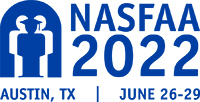Promise Programs: Hopes, Dreams, and Mission Fulfillment
By Beth Maglione, NASFAA Executive Vice President
Moderator:
Shane Maloney, Associate Director of Financial Aid at the University of Wisconsin-Madison
Speakers:
Helen Faith, Director of Financial Aid at the University of Wisconsin-Madison
Nicholas Hillman, Assistant Professor, Educational Leadership & Policy Analysis at the University of Wisconsin-Madison
Elise Marifian, Ph.D. candidate at the University of Wisconsin-Madison
Rachelle Feldman, Vice Provost of Enrollment at the University of North Carolina at Chapel Hill
Cristi Millard, Director of Compliance &Special Projects at Salt Lake Community College
At the Monday morning session "Promise Programs: Hopes, Dreams, and Mission Fulfillment," a panel of financial aid leaders and researchers discussed their experiences with promise programs at their respective institutions. College promise programs are increasingly popular thanks to their simple messaging around affordability, predictability, and consistency.
While the various programs use different criteria and methodologies to meet students' need, Helen Faith, director of financial aid at the University of Wisconsin-Madison, reported that the guaranteed funding-continuity inherent to these programs allows students and families to feel secure and empowers students to persist.
Rachelle Feldman, vice provost of enrollment at the University of North Carolina at Chapel Hill, spoke about UNC's Carolina Covenant, one of the earliest such programs to guarantee that — for qualified low-income students — the institution will meet full need with zero loans and provide co-curricular support.
Faith and UW-Madison professor Nicholas Hillman discussed the balance in attempting to keep their program — Bucky's Tuition Promise, or BTP — simple to understand and communicate, while also serving the needs of all beneficiaries. For instance, UW-Madison researchers and decision-makers have ongoing discussion about whether to award partial scholarships to those who are just above the income threshold, to avoid a stark "cliff effect" that would act as a deterrent to those families who might be just above the tuition threshold.
Bringing a researcher's perspective, Elise Marifian, a pre-doctoral fellow at UW-Madison, collaborated with the Office of Student Financial Aid and their Student Success Through Applied Research (SSTAR) Lab to examine the enrollment impacts of BTP.
Her key research question was how BTP affects the school's enrollment yield.
"Ideally we wanted to determine the causal effect, not just the correlation," she said.
Marifian found that in the first year of the program, being eligible for Bucky's Tuition Promise increased the probability that a student from Wisconsin would accept an enrollment offer from UW-Madison by a significant percentage.
Cristi Millard, director of compliance & special projects at Salt Lake Community College, reported similar positive outcome with "SLCC's Promise," saying that retention and graduation rates have increased slightly over the life of the program, although she noted that fewer students are currently utilizing the program, possibly due to the additional HEERF dollars given to students during the pandemic.
Publication Date: 6/27/2022

You must be logged in to comment on this page.